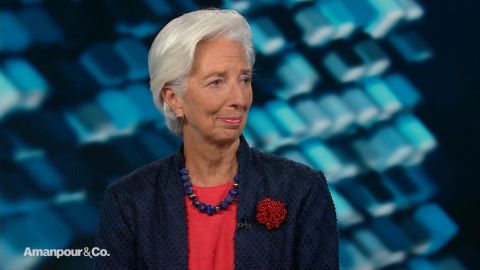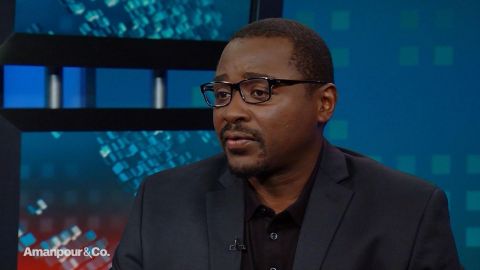Read Transcript EXPAND
CHRISTIANE AMANPOUR: The Alvin Ailey American Dance Theater, an American cultural treasurer was born out of the Civil Rights struggle of the 1950s. Its founder Alvin Ailey used the language of dance to grapple with racial discrimination, America’s original sin. Sixty years later, the Ailey company is still going strong with Director Robert Battle at the helm. Battle grew up in one of Miami’s toughest neighborhoods using the security bars on his window as his ballet bar. Now, as Ailey’s Artistic Director, can he still lift up audiences at this time of discord and division? Our Hari Sreenivasan sat down to find out when he spoke with Robert Battle in New York.
(BEGIN VIDEO TAPE)
HARI SREENIVASAN: Robert, thank you for joining us.
ROBERT BATTLE, ARTISTIC DIRECTOR, ALVIN AILEY DANCE THEATER: Thank you.
SREENIVASAN: Survival for an arts institution is not a given. The fact that is survived 60 years when you have seen other institutions rise and fall in that time.
BATTLE: Yes, I think because the mission is very clear. Alvin Ailey said it best, “Dance comes from the people and should always be delivered back to the people,” always remembering why we are on that stage, always remembering that it’s the act of communicating that is the most important in what we do and so the audiences that come to see us, they don’t just see an Ailey performance, but they feel it, they take it with them. They want that feeling again because it leads them uplifted. That accessibility that Alvin had in his own person is the same blood that flows through the organization.
SREENIVASAN: And this is a company that tours pretty aggressively. You are in dozens of cities, you’re overseas, why?
BATTLE: Yes, because that’s part of the mission, to bring dance to as wide of an audience as possible. To understand that the arts sort of, it’s our passport to the world. That dance communicates where language falters. And so the notion that we can tell our story all over the world, I think was very important, especially for a company that was majority black. To tell that story, so we don’t just entertain, but we educate. And part of that is the traveling, the touring, reaching different countries and audiences. So no matter if we’re across the street or across the ocean, the truth is what we are getting at.
SREENIVASAN: But how does dance cut through that rural versus urban, that red state versus blue state line because you are not discriminating where you go.
BATTLE: No, no. I think that dance in a way is wonderfully ambiguous. So that where language says what side you stand, in a way, dance has this way, before you even know what it’s about, you find yourself caught up in it. You know that it’s able to deliver a hard truth but with a sense of spirituality I think that is universal.
When I think about that, I think of one of the most important dances ever created, which was created by Alvin Ailey in 1960 and that’s “Revelations.” We close pretty much every performance with “Revelations.” And that work, no matter where we are, when I first took over the company, we were in Russia. It’s been – “Revelations” is the sweetest spiritual and it expresses the experiences of African-Americans in this country and how we overcame through faith. And here I was, about to take over the company, we happen to be in Russia and we see people in the aisles as if they were in a black church somewhere, sort of celebrating this dance. I think it speaks to his ability to break through and communicate to whomever, wherever, whenever.
SREENIVASAN: Does “Revelations” take on a different meaning given the current climate that we are in today where we are seemingly questioning some of the basic things that we thought we sorted out in the ’60s and ’70s?
BATTLE: Yes, I think that the art, certainly dance, is always important because it’s the artifacts of human survival. It celebrates our common humanity. And in times where we can be fooled into thinking that we don’t need each other, I think it’s so important that the arts speak loudly. And so I think it’s even more important now that we come and we see this company, that we come and see this rich legacy that’s celebrating 60 years. There’s a reason why, it’s because Alvin Ailey told the truth in his work. You don’t have to question the truth, it just is. And so I think, this is where the company means the most in times like these.
SREENIVASAN: Is there a better pipeline today for American dance? Obviously, Alvin Ailey created this as a space to start highlighting the fact that African-American dancers could exist and choreographers could exist. Where are we now versus where he started 60 years ago?
BATTLE: Because he started 60 years ago, we have so many dancers these have come through the company as dancers or through the Ailey School that are teaching now or whatever it is they are doing or just patrons of the art. When I think of the arts and education programs that we have, one of them is called Ailey Camp that Alvin Ailey started 30 years ago. This was one of the last programs he implemented before he died. He started it in Kansas City and now, it’s in about 10 or 11 cities for young people who are sort of underserved in their communities to have access to the arts. It’s life-altering.
So we can’t always measure the impact by numbers. But we know that it is there. We know that people have benefited and continue to carry that legacy forward.
SREENIVASAN: You are not the born dancer. If you come out with bow legs, nobody says, “This is the guy that’s going to run the hundred meter hurdles or go to dance.”
BATTLE: Right.
SREENIVASAN: How did this happen?
BATTLE: Well, I think that that’s sometimes the very thing that you are up against is the thing that becomes your best self. I was also shy, didn’t like to talk a lot. I know it’s hard to tell now. And so luckily, my great aunt and uncle who took me in when I was an infant got me to the hospital to get braces for my legs that they had to put on every night to get those legs straightened.
But the artistic part really came I think, from who I call my mother, who was really my cousin because she played piano for the church we went to.
She had a group called the Afro Americans. That was a group of her friends who did poetry and song relating to the black experience. So I was already sort of hearing all of that stuff, all of those poems, all of those stories, where it was a part of my growing up.
SREENIVASAN: That was your norm.
BATTLE: That was my norm in a way. So I didn’t understand this whole thing about performing arts. It’s just what we did. It was part. And so when I first saw “Revelations” growing up there in Liberty City, a tough town. In fact, I studied Martial Arts because I had a soprano singing voice and I played classical music.
SREENIVASAN: Those are combinations for being bullied.
BATTLE: Oh yes. Oh yes. I had it all. I had the t-shirt, “Bully me.” And so to protect myself, I studied Martial Arts with a friend’s father who was a retired third degree black belt, and so here comes the Alvin Ailey American Dance Theater coming to perform in Miami, as they do, as we tour, as you know, we were bused in as young people from different schools to see a mini performance which is a performance just for young people. And seeing “Revelations,” hearing those spirituals that I heard as a kid, seeing people who look like me on the stage, the effect that that had on me, the curtain went down, then I went up.
And I remember thinking I want to be like that. I didn’t think some day I would be in New York City, the third director of that company, but it happened. So I think that for young people, I always say start where you are. That your imagination holds the keys to your success. Nobody can take that away from you. You don’t have to pay for it. And so seeing “Revelations” reminded me of that and here I am today.
SREENIVASAN: So you’re in a neighborhood where you’ve got security bars on the window, you’re using those as your ballet bars. Who did you have on your walls growing up?
BATTLE: Gosh, I had this wonderful piece of wood that the termites got to eventually, but I used to, in “Dance” magazine, I would sort of cut out pictures, Judith Jamison, Mikhail Baryshnikov, Alvin Ailey, Arthur Mitchell – whatever it was, I would cut it out and I would sort of paste it on that board.
And then at night, I would take a flashlight and I would just look like I was watching a movie or something. But those images were important because eventually you walk into those images. So, yes, it was wonderful to have that to look to.
SREENIVASAN: How much of that factored into when you actually get on stage, do you remember? Is there a performance, whether it’s in high school or when you started to realize like to choreograph things, I like to put things in perspective as well?
BATTLE: Well, you know, what I do remember is that I like to tell people what to do. That, my mother had to tell me, your friends are not your servants and they are not your subjects. So she told me, she was like, “Listen, they don’t like this.” But this sort of notion, though, of wanting to lead, wanting to be in front, wanting to inspire, I wanted to be a preacher when I was a kid because the preacher so moved the crowd, I wanted to move the crowd. All of that has been in my DNA.
SREENIVASAN: And you still want to move the crowd.
BATTLE: I still want to move the crowd and I still in my own way am preaching.
SREENIVASAN: It’s a larger – a different church.
BATTLE: Yes, a different church and Gospel is dance that can move people and that can change people’s hearts.
SREENIVASAN: Help me understand dance because I haven’t been exposed to it and perhaps there’s other members of our audience, too, so how does a dancer use their entire body as an instrument? How do you do that?
BATTLE: Part of that really I mean is the training. It’s the training and the Ailey School, we are one of the best schools in terms of that hard-core training that you need to be able to articulate all of those parts of your body to make a statement. Often though for me, I think about the audition process.
I think of my 32 fabulous dancers. They speak out for a minute and say how wonderful they are because they are able to communicate all kind of feelings through movement, whether it be anger, whether it be fear, whether it be joy, or whatever it is. And I heard Maya Angelu say something one time, to think of your whole body as an ear.
SREENIVASAN: As an ear.
BATTLE: Yes, so that sense of receiving and then being able to sort of speak it as you hear it, I think you find those dancers who are able to communicate in that way, who are able to go beyond the steps, beyond the movement and touch your heart. I mean that is unique and you can’t really teach that.
SREENIVASAN: Robert Battle, thanks so much for your time.
BATTLE: Thank you.
About This Episode EXPAND
Christiane Amanpour speaks with Kellyanne Conway, Counselor to President Trump, and Christine Lagard, Managing Director, International Monetary Fund. Hari Sreenivasan speaks with Robert Battle, Artistic Director, Alvin Ailey American Dance Theater.
LEARN MORE


